Author: Derek. Chen, Dr. Nick
1. AI Empowers the Traditional Gaming Industry
Large-scale games involve extremely rich content such as 3D animation, special effects, audio, art, and text. The development process generally takes a long time and is quite complex, with high requirements for industrialization, real-time interaction, and interactivity. Development units often need to invest a large amount of manpower, material resources, and financial resources on an annual basis. For a long time, in the traditional game development field, the three elements of cost, quality, and efficiency have formed an "impossible triangle" where only two out of the three can be chosen. For example, "Red Dead Redemption 2" took 8 years and over 1,200 full-time developers at a cost of nearly 300 million US dollars to create a realistic map of over 28 square miles and 1,000 NPCs. Now, with the powerful functions of AICoin, game developers can break free from the constraints of traditional game development, reduce development thresholds and costs, and significantly improve game development efficiency. 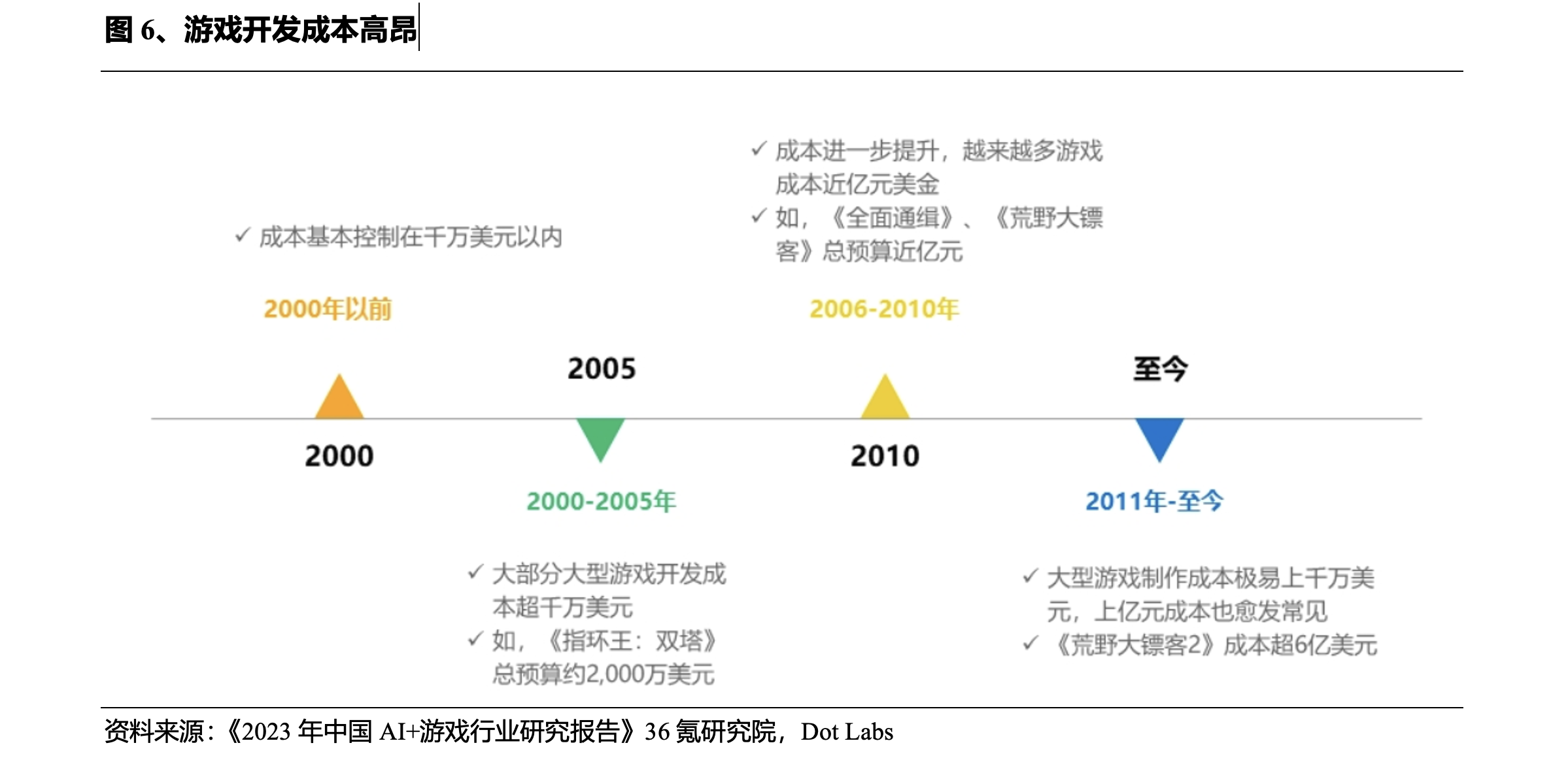
AICoin can provide precise and powerful empowerment for game development, plot planning, character interaction, and online operation through technologies such as machine learning, deep learning, and natural language processing. Specifically, AI can empower traditional games in the following three aspects: pre-production of games, in-game experience operation, and the subversion of the game industry structure.
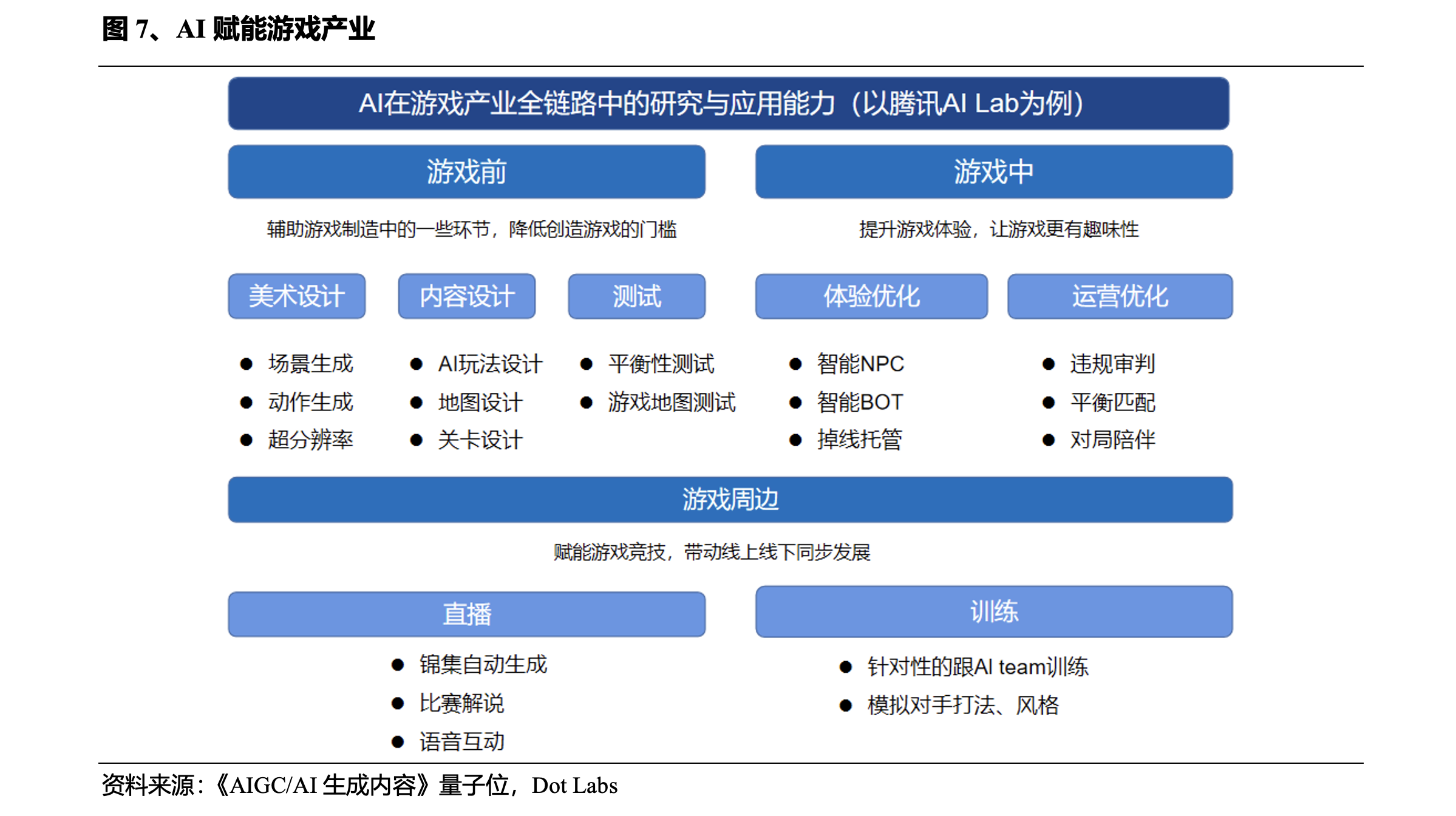
1. AI Empowers Game Production
In terms of game production, AI provides great assistance to workers in various aspects such as art and planning.
AI is used for the generation of various game assets, achieving cost reduction and efficiency improvement
AICoin's different functions can be applied to various aspects of game production, such as plot design, character design, voice acting and music, original art design, game animation, 3D modeling, and map editors, to generate various game assets. 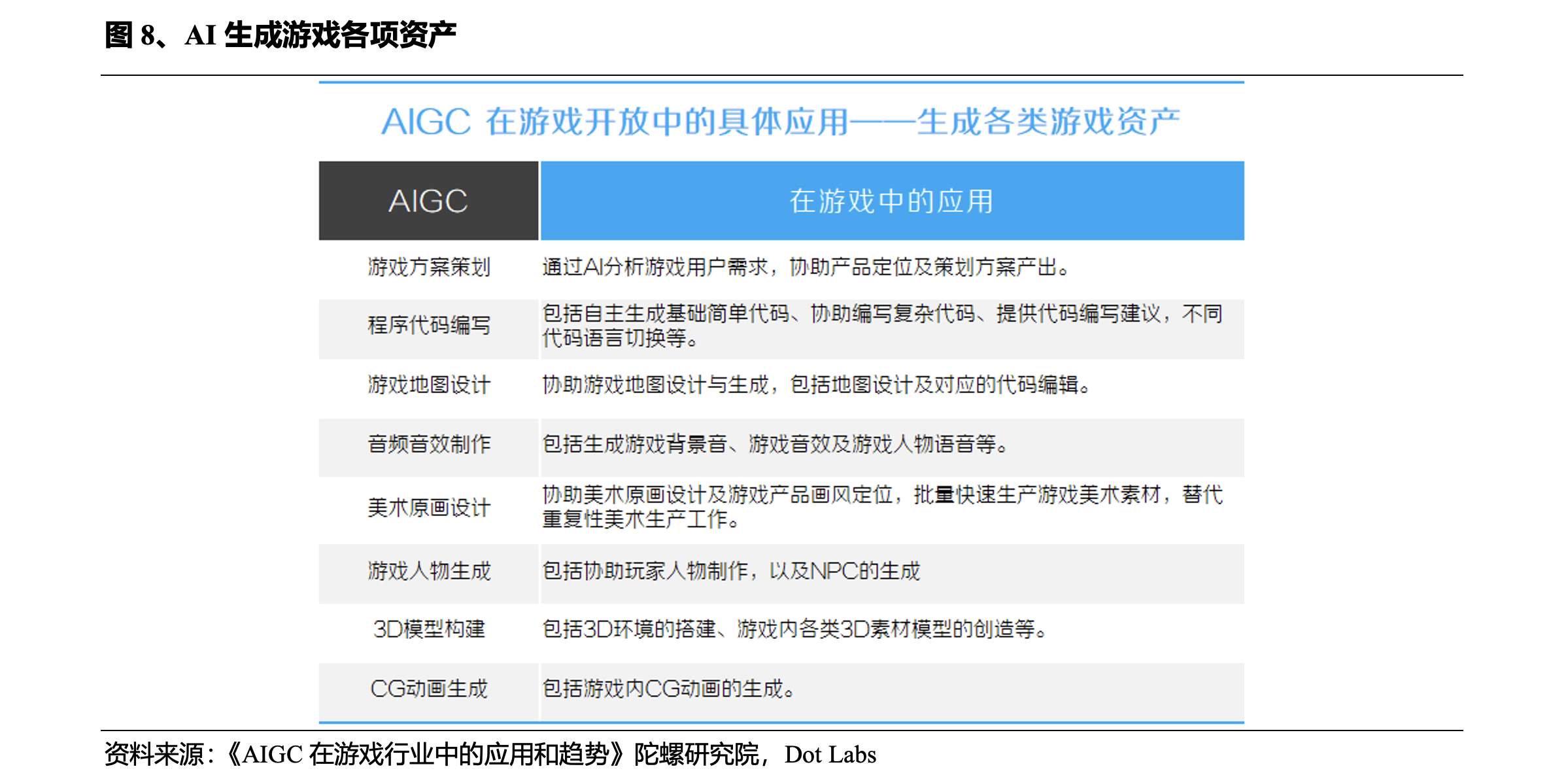
Taking the AI-generated image company Scenario as an example, Scenario is the first commercial AI-generated game asset platform. The platform can train AI models based on user-input text and reference images. Users upload training data to the platform, such as characters, props, vehicles, weapons, skins, buildings, concept art, pixel art, and sketches, and then, within a few clicks, users can create their own generative AI engine, thus creating game assets that meet game production standards based on the input text and reference images.
In the process of original art design and 3D modeling, AICoin, such as Midjourney, can provide good creative assistance, while Stable Diffusion, as an open-source model, can provide finer control. Epic Games showcased their latest Metahuman Animator technology at GDC 2023, which allows developers to create high-quality animations in minutes, generating facial skeletons with just three frames of footage, and also supports generating animations from video and audio. In the demonstration, the presenter recreated the facial expression details of the live performance in the digital space in just 2 minutes. Opus.ai has developed a new text-driven 3D world generation method, which supports users in creating dynamic lighting, camera control, terrain, trees and animals, buildings, roads, and animated characters through text input. In this application, users can create 3D game scenes and various components and dynamic effects by simply typing.
In terms of game scenario planning, Tencent AI Lab showcased AI level generation technology at GDC 2022, where AI can generate over a thousand high-quality levels in a matter of hours. In terms of copywriting, AI can also provide outlines and dialogues for games, accelerating game content production.
AICoin's powerful generative capabilities not only improve the efficiency of game producers but also significantly reduce costs. The game industry has embarked on an accelerated growth path with the help of generative AI.
AI is used for assisting game testing
Game testing is a key stage in the game development cycle, with the aim of ensuring game quality, reducing post-release risks, and providing players with a better gaming experience. In game testing, testers will use different testing techniques for different testing targets, such as game mechanics, game flow content, game systems, and device compatibility, to record issues found in the game and report bugs through management tools to provide feedback to developers.
In specific game testing applications, for example, the Japanese card game "Shadowverse" uses AI to test card combinations and trains AI with data to automatically play the game, in order to discover potential bugs and balance issues, greatly improving efficiency and reducing testing costs. The mobile game "Subway Surfers" uses AI to automatically test various actions in the game and the reasonableness of obstacles in the game.
2. AI Agents Enhance Player Gaming Experience
Increasing playability in level design and game difficulty
In terms of game experience, there are already rudimentary forms of native games and innovative gameplay around AI's natural language generation, image generation, and intelligent NPC capabilities. The AI system "Juewu" in "King of Glory" is currently widely used for level evaluation and testing; "Left 4 Dead" also uses a system called "Director" to adjust the generation of zombies, the placement of items, and the overall difficulty of levels based on the player's performance, ensuring the playability of the game.
Real-time and diverse NPC dialogues enhance the gaming experience
In traditional games, the storyline is pre-designed, and players can only experience limited game content in a fixed order, so the revenue and content reserves of role-playing games are highly related. After the birth of AI Agents, NPCs in games have been given "life". AI NPCs are designed to have a "life" like a human, remembering what happened each day, and every interaction with the player will change the NPC's life trajectory, creating game content with unlimited possibilities.
Ubisoft's La Forge R&D department has developed an internal AI tool called Ghostwriter, which can help game writers generate initial drafts of NPC dialogue when triggering events, such as NPC conversations, enemy dialogues during combat, or dialogues triggered when players enter a certain area. These tasks used to require game writers (planners) to spend a huge amount of time designing. With the Ghostwriter tool, AI can automatically generate samples for selection and modification based on the basic settings of NPCs, saving a lot of time and allowing writers to focus on other core plot elements.
A representative application case in China is Netease's use of intelligent NPC systems in "Justice" where over 400 NPCs in the game are loaded with Netease's Fuxi AI engine, each with independent personality traits and behavior patterns. Compared to traditional game NPCs, intelligent NPCs have greatly increased freedom and openness in player-NPC interactions. An example from abroad is "Mount & Blade II: Bannerlord", which has achieved dynamic responses from NPCs.
AI for game marketing and optimization
AI can be used for media buying, from creating media buying materials to analyzing media buying effects, and executing media buying, AI can improve efficiency and quality, and achieve cost reduction and efficiency improvement. 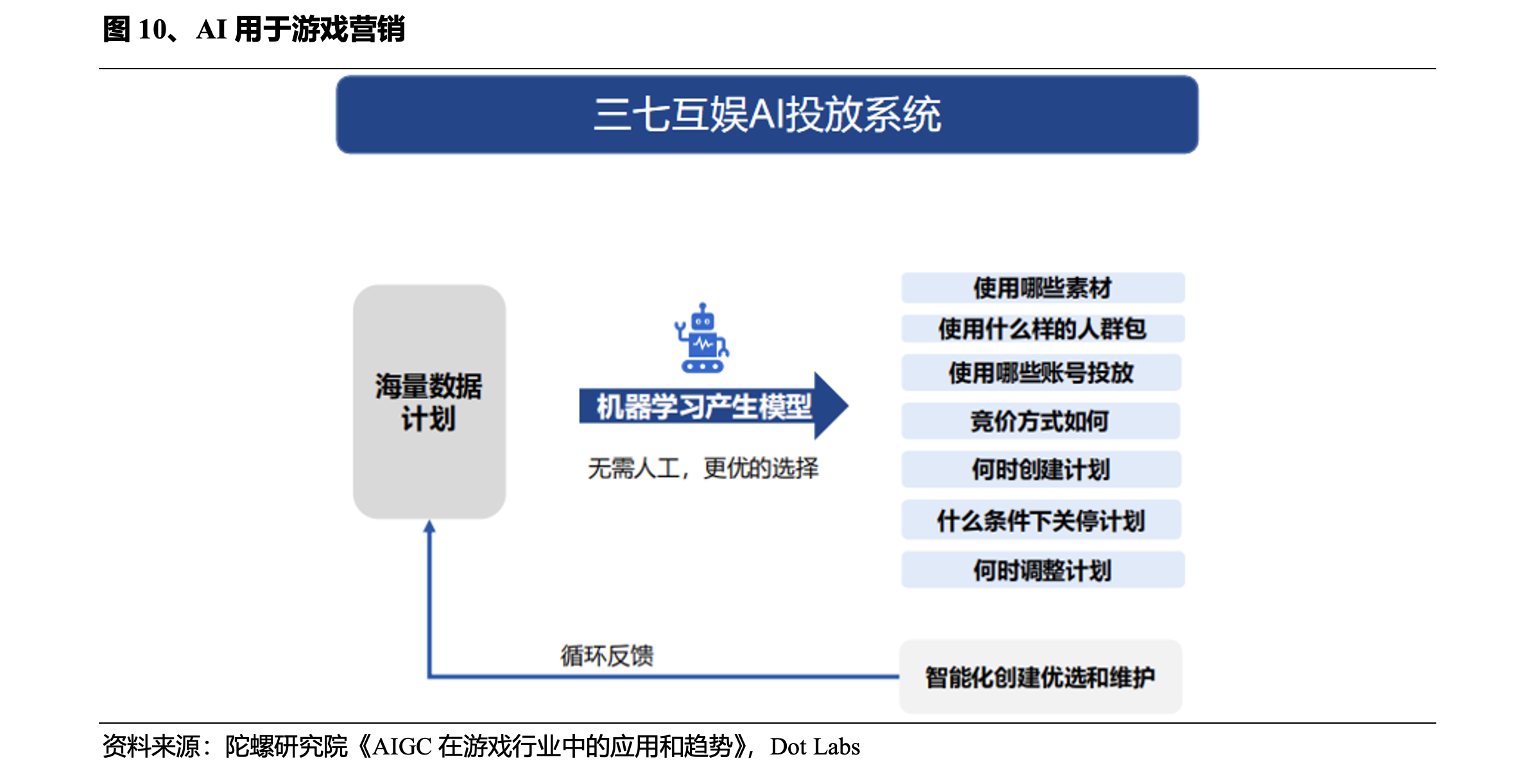
3. AI Subverts the Game Industry Structure
l The entry barrier of the gaming industry has been lowered
AI has significantly reduced the development costs for game producers. Previously, generating game assets and drawing animations required manual drawing of each frame, but now AI can greatly reduce costs. This has broken the previous high investment model for games, providing conditions for small game developers to break through.
l Further empowerment of player rights
With the support of AICG, every player can become a planner and complete tasks such as coding, art, and testing through UGC empowered by AI, allowing players to create their own games and achieve "decentralization of games".
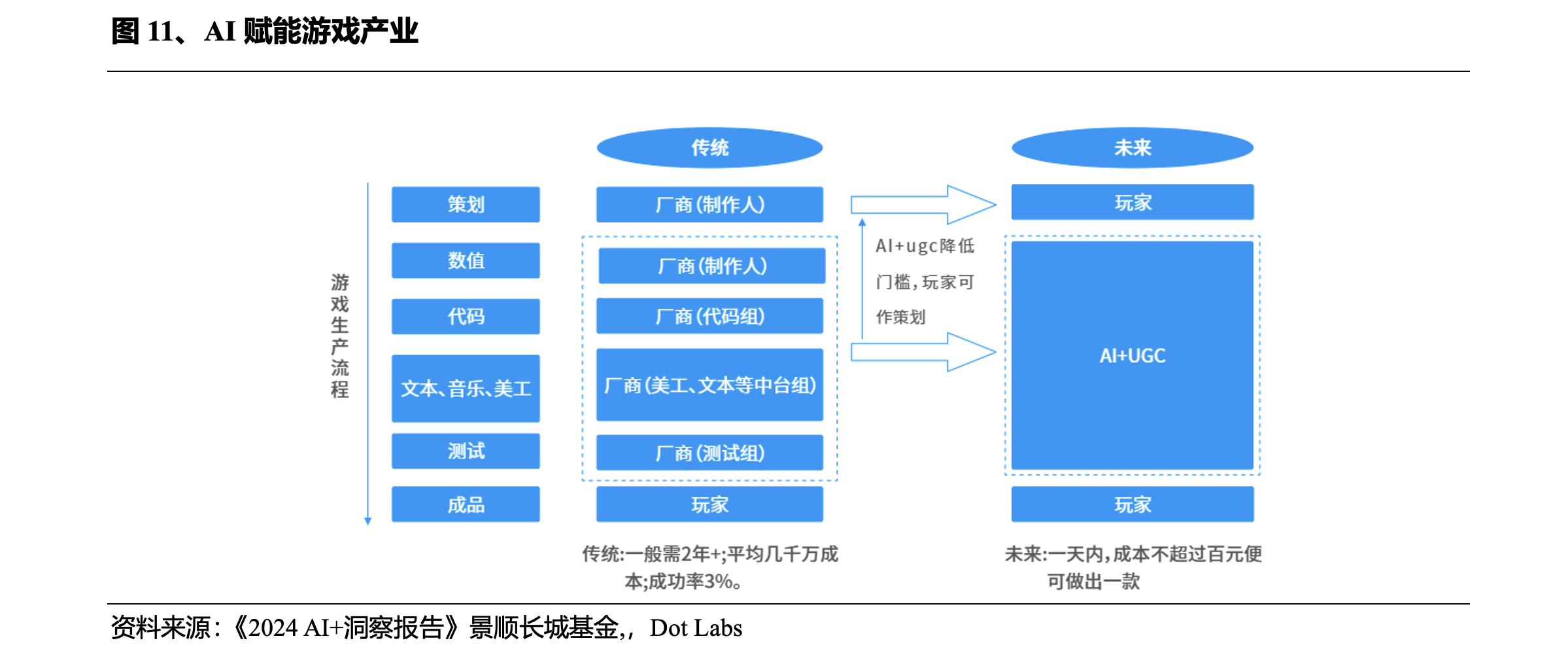
二、 How does AI drive the growth of GameFi?
Overall, the reasons for the GameFi projects experiencing a boom followed by a downward spiral can be summarized as follows:
The short-term attraction for players was the "p2e" mode, which was very popular in 2021, but its appeal declined later on. In 2021, as many as 67.9% of respondents believed that "p2e" was the biggest industry driver. This mode was unique when the gaming industry was just emerging, attracting many players. However, over time, the P2E mechanism has lost its importance as an industry driver, dropping to eighth place in the 2023 survey.
The speculative nature of games outweighs the gaming attributes, which is unfriendly to players. Most users participating in blockchain games in the GameFi market are cryptocurrency players, and the quality of the games varies. The game content emphasizes strategy and speculation, and the economic model has a short maintenance period. Some non-crypto players even view these blockchain games as online gambling, leading to a high number of high-risk GameFi speculators. New players need to purchase in-game items or assets to play the game, and although they can earn back from the game, if the game's token circulation increases and the playability is poor, the token value will decrease, making it difficult for players to recoup their investment. The focus on asset value rather than gameplay makes it difficult for GameFi projects to sustain. This issue stems from several inherent factors of the play-to-earn model. A key issue is the unsustainable token economy that often drives these projects. When token rewards exceed the actual value generated in the game, an unsustainable inflation cycle occurs, leading to price drops and loss of player interest.
Poor game playability, unable to retain game users and attract new players. GameFi games are mostly single-scene, NFT-based, and unable to attract new players. Compared to traditional games, the playability is insufficient, and the development difficulty and cycle are short. Many small games of varying quality have quickly dominated the market. Increasing the application scenarios to extend the lifecycle and sustainable revenue model of blockchain games is the main goal of GameFi.
During the quiet period of GameFi, major companies and manufacturers are working to address the problems left over from the previous period.
In terms of user acquisition, innovative expansion of the P2E model to sustainably attract users. For example, Stepn gained popularity in May 2022 by expanding play-to-earn to move-to-earn. The basic gameplay of STEP is simple: players equip NFT sneakers in the game app and earn token rewards by running in the real world. The earned rewards can be used to upgrade or repair the sneakers to increase the "earning" efficiency, or can be sold directly. This is one of the most popular weeks for Stepn, with 10.7% of super users, and the number of users entering SOL reaching 1.79 million, almost equal to the total sum of all users who entered the market. This project's real contribution is 39% of high-level users entering SOL, almost on par with 920,000 regular users, which is quite remarkable. In just a few months, it has achieved a user base of millions. Based on this, X2E games have emerged. The "X" in X2E can be defined as any human behavior, such as gaming or mobile use, and earning rewards through these behaviors. Unlike early games purely driven by profit, X2E places a high emphasis on community culture and values, often using meaningful real-life or creative behaviors as core game mechanisms.
In terms of user retention, first improve the playability of the game. The development of higher-quality game products has begun, with more 3A major factory teams and members joining compared to the previous stage, greatly improving the overall game quality. A small number of traditional game players with a curiosity mindset are attracted to the relatively high-quality games and join the blockchain game player community, gradually bringing blockchain games into the public eye, making GameFi a normal attribute of games.
Secondly, solve the financial sustainability issue. If the game itself encounters problems with the financial mechanism, DAO plays a crucial role in maintaining stability on the secondary market for tokens or repurchasing tokens from the market through a bond mechanism to maintain healthy liquidity. GameFi will solve the problem of a single-game economic model on the previous stage and avoid cycling within a single game.
The current focus of the GameFi field is shifting to the intrinsic value of the game itself, with continuously attracting and retaining users as the new development focus. The empowerment of AI also plays a role in the above aspects.
1. Further expansion of the P2E model with AI
With the support of AI, GameFi can further expand the "play to earn" model. The previous round of GameFi's boom was achieved with AI technology realizing the effect of "move to earn". This time, AI is expected to lead GameFi into the "love to earn" era and drive a new round of growth.
(1) Sleepless AI
With the support of AI, GameFi can further expand the "play to earn" model. The previous round of GameFi's boom was achieved with AI technology realizing the effect of "move to earn". This time, AI is expected to lead GameFi into the "love to earn" era and drive a new round of growth.
(1) Sleepless AI
Sleepless AI has further extended the "pay to earn" mode. By using AI to shape "love to earn" and attract users. Sleepless AI is a pioneering Web3+AI virtual companion game that uses AIGC and LLM to create rich story-based gameplay and interactive character development, providing players with emotional support and immersive gaming experiences.
The flagship game of this project is HIM, which uses advanced large language models to enable virtual characters in the game to generate natural and distinctive dialogue content based on different game situations and personality traits. This application of technology greatly enhances the authenticity of the characters and the immersion of the players. It aims to create a comprehensive, three-dimensional virtual image, making it a part of the players' daily lives. The long-term goal of HIM is to establish a metaverse of AI boyfriends, AI girlfriends, and AI pets, providing support and companionship to users. HIM not only signifies the natural integration of AI and games but also demonstrates how Web3 games can use AI technology to create a completely new interactive experience.
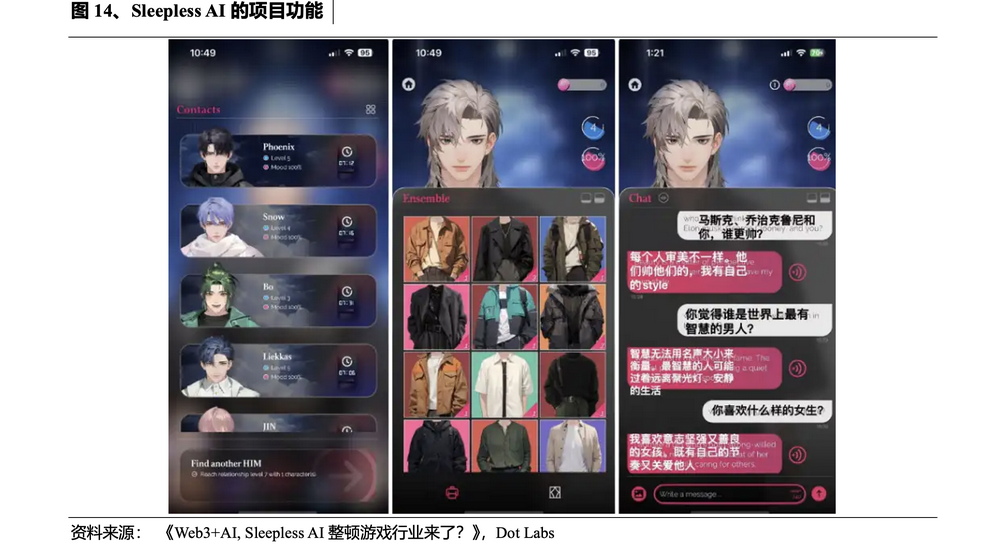
Project Information:
X Account: https://x.com/SleeplessAI_Lab
MCP (as of 2024.6.15): 109,802,401
FDV (as of 2024.6.15): 884,633,856
(2) Palio
Palio
The Palio project has also joined the wave of "love to earn" using large-scale model technology. Unlike Sleepless AI, which accompanies players with virtual companions, Palio accompanies players with virtual pets. From a technical perspective, Palio is developed by a team of researchers and engineers from OpenAI, Stanford University, and Google Brain, based on the use of large language models (LLM) as the core of the proxy system. Specifically, the Palio large language model performs well, with a language IQ of 155 according to the WAIS benchmark. This score exceeds that of the average person, reflecting its outstanding language comprehension abilities. To better enhance the companionship attributes of the game, Palio has put effort into enhancing empathy in AI. In order to convincingly convey emotions through artificial intelligence, it is necessary to fine-tune it using real emotional datasets. PalioAI has collected a large amount of such data, enabling it to improve its algorithm. This makes PalioAI more advantageous than other existing knowledge-based LLMs, allowing it to resonate more skillfully with users and provide detailed feedback. Finally, PalioAI's large model excels in long-term memory compared to other companion games, using retrieval-augmented generation (RAG) to give PalioAI true meaningful memory.
Specific Applications of Palio in the Game:
• Assisting Players in Completing Tasks: Palio can provide explanations and hints for game tasks to help players complete them smoothly.
• Providing Game Information: Palio can provide background stories, character introductions, and gameplay explanations to help players better understand the game.
• Offering Game Advice: Based on the player's game progress and performance, Palio can provide game strategy advice to help players improve their gaming skills.
Project Information:
X Account: https://x.com/PalioAI
MCP (as of 2024.6.15): 813.25 ETH
SpaceCatch
Twitter: https://x.com/spacecatch_io
Official Website: https://spacecatch.io/
Whitepaper: https://whitepaper.spacecatch.io/
AI can also empower the previously popular "move to earn" model. SpaceCatch is a "move to earn" game driven by artificial intelligence. The game team has rich experience in AI implementation, especially in game tasks. Using artificial intelligence to create game tasks tailored to individual players' behaviors, level/avatar specifications, and in-game activities ensures that players feel the game is personalized according to their preferences.
Project Information:
X Account: https://x.com/spacecatch_io
MCP (as of 2024.6.15): 916.57 ETH
2. Players Creating AI to Join Game Competitions
In this new mode, players can create their own unique AI in the game and let the AI participate in competitive battles with other players. Each created AI is generated based on the player's unique data information. This mode combines creativity and competitiveness, and is worth paying attention to.
(1)AI Arena
AI Arena is the first game to integrate Human x AI collaboration. In this game, players transfer their personal data to artificial intelligence through the process of imitation learning. In fact, the process of creating AI is also the process of training the AI's large model by the player.
Creating NFT: When players purchase new NFTs for game matches, the core neural network parameters are randomly generated. This means that the neural network will initially perform random operations, as the network has not yet developed any skills.
Data Collection: Players demonstrate operations to AI, essentially creating a list of actions for AI to mimic and learn. In machine learning terms, players are creating a dataset for AI training. Players need to consciously create a useful dataset for AI to learn to mimic while playing the game.
Selecting and Applying the Right Dataset: How much does the player want the artificial intelligence to remember from previous training? Determining the focus of AI training. For example, players can tell their AI to focus on a specific training course.
Training: After collecting and configuring the data, the AI is trained to update its parameters. The player's AI will continue to evolve and adapt to new strategies.
Overall, the above process can be understood as AI learning from the player, capturing the player's skills, and ultimately competing for the player. The better the player performs as a trainer, the better their artificial intelligence will be. After creating a unique artificial intelligence, it can participate in competitions. Game players purchase, train, and battle AI-driven NFTs. Players compete to develop better training techniques to earn rewards.
Project Information:
X Account: https://x.com/aiarena_
(2)ASTO
In this project, players autonomously generate AI agents.
The AI agent created by the player consists of three parts: the brain NFT, which is the core of the agent, the appearance and operation mode of the agent, and the memories stored in the brain memory tree, used to encode the behavioral strategies for the agent's learning. The ASM platform formed by this core technology provides the ability to create AI agents as NFTs for any application (e.g., games, metaverse, finance).
The ASM agents created by players can be trained in the "gym." The gym is a networked GPU cloud computing provider (similar to miners) that runs training algorithms for specific ASM applications (e.g., popular game or DeFi market trading bots). Owners use ASTO tokens to pay for training fees.
Currently, there are three games driven by the ASM project:
Artificial Intelligence Football Association (AIFA)
AIFA is a 4x4 football game autonomously powered by ASM Brain-powered All-Stars. Players can collect and trade All-Stars to build a winning team. Players will be able to train their ASM brains in the AI gym to improve the skills of their All-Stars, and then watch them evolve into metaverse football champions.
Muhammad Ali - The Next Legend
ASM has partnered with Muhammad Ali Enterprises and Non-Fungible Labs to create the world's first AI-driven metaverse boxing game. Players will train boxers combined with any ASM Brain, train and compete for the legendary title, following in the footsteps of the greatest Muhammad Ali.
AI League: FIFA Women's World Cup AU·NZ·2023™ Edition
ASM has partnered with FIFA to bring a new era of street football to the metaverse. In the AI League mobile game, players start as managers of four completely unique AI All-Star football players.
The mode of players creating AI to participate in competitions is a major advancement in competitive games. In traditional competitive games, the player's ability to create characters is determined by the game manufacturer, with limited autonomy for the player. However, in this new mode, each AI character created by the player is unique, making the competitive process more realistic and greatly increasing the player's operational space.
Project Information:
X Account: https://x.com/altstatemachine
MCP (as of 2024.6.15): 16,703,261
FDV (as of 2024.6.15): 49,591,301
3. AI Promotes Cost Reduction and Efficiency Improvement in Games, Enhancing Game Quality
The discussion in the first part about AI's cost reduction and efficiency improvement in the traditional gaming industry also applies, and it has shown a more effective role compared to traditional industries. From the perspective of games, although Web3 games are beginning to focus on improving gameplay and playability, there has been a relative lack of high-quality game content in the market from 2021 to 2023.
According to Game7 Research data, currently, more than half of Web3 games are developed by independent creators or small teams, while 3A or 2A level productions only account for 6%. Some projects focus too much on technology and economics, neglecting the excellence of game design, innovation, and diverse content. This may lead to player churn and market saturation risks, limiting the industry's long-term development.
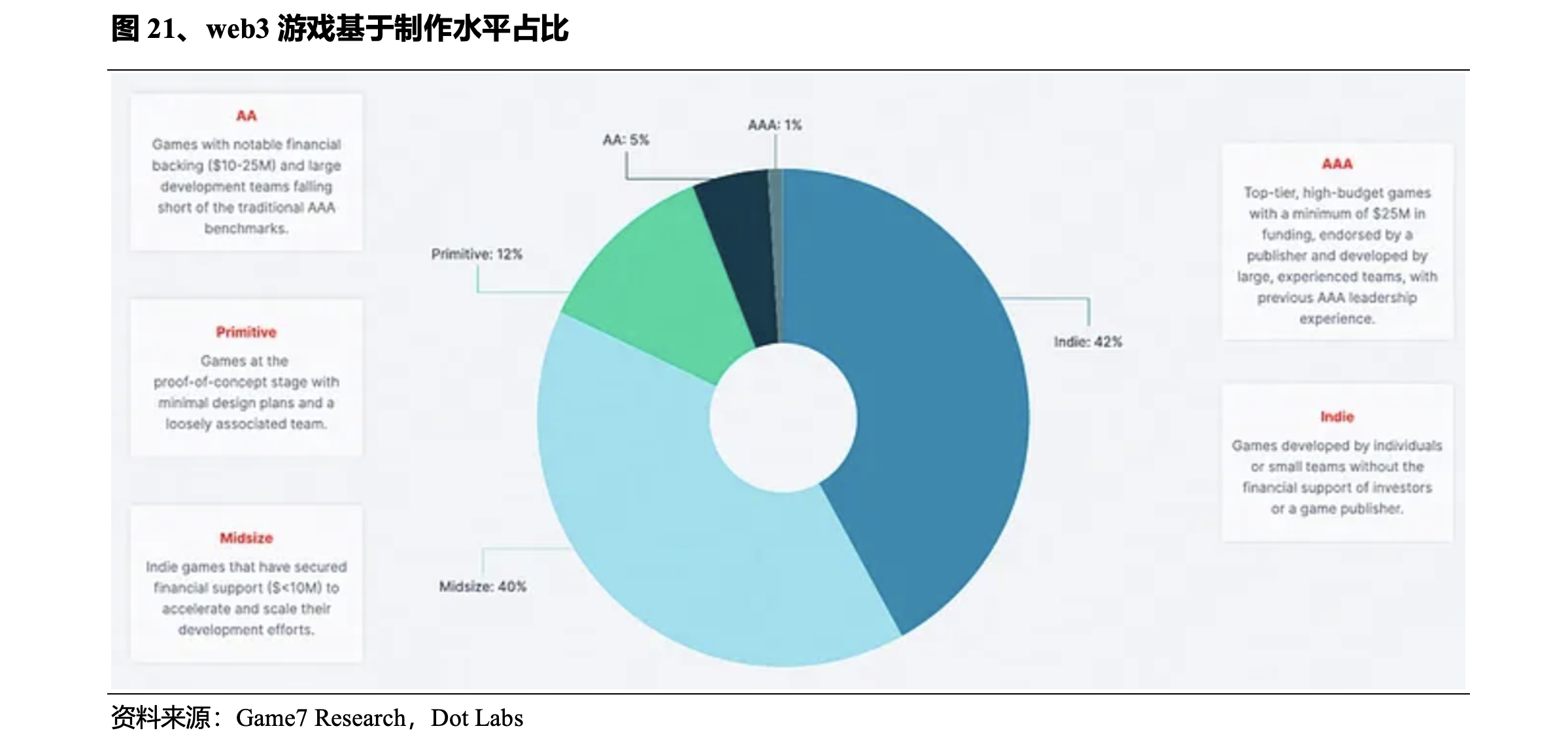
Currently, Web3 games are moving towards high-quality graphics, rich content, and excellent player experiences, even advancing towards the 3A production direction by attracting more Web2 players through improved playability. However, before the emergence of generative AI, the massive investment cost of high-quality AAA games made small teams in the web3 field hesitant. The emergence of generative AI has reduced the production cost of games, allowing more small teams to participate in the pursuit of high-quality games. From an industry-wide perspective, this round of the gamefi market will see the emergence of more high-quality games, accelerated by AI, leading to the emergence of truly valuable and playable games.
(1) EXVERSE
EXVERSE is a 3A-level first-person shooter game that integrates intense shooting gameplay with innovative Web3 mechanisms built on Unreal Engine 5. EXVERSE uses various technologies to enhance the quality and realism of the game. It uses the virtualized geometry system Nanite to render pixel-level details, Lumen for fully dynamic global illumination and reflection, and Chaos for movie-quality destruction, fragmentation, and large-scale scene demolition. Chaos also supports dynamic static mesh, cloth, hair, vehicle, and rigid body animations, integrated with Niagara for auxiliary effects such as dust and smoke.
The authenticity and high quality comparable to traditional games are the core selling points of this game. With the continuous empowerment of AI technology, more high-quality 3A-level web3 games will emerge in the future.
Project Information:
X Account: https://x.com/exverse_io
MCP (as of 2024.6.15): 1,484,312
FDV (as of 2024.6.15): 18,461,655
(2) KOMPETE
This game is also a 3A-level shooting-dominated game. It integrates various gameplay elements, placing players in landscapes with points of interest, race tracks, basketball courts, golf courses, and more. The game is a free multiplayer game with no entry barriers and can be accessed on any device.
The highlight of this project is that it is an all-in-one multiplayer game with gunfights, racing, battle royale, basketball courts, golf courses, makeup shops, social deduction, and tournaments. Players experience a more diverse and rich gaming experience in the game.
Project Information:
X Account: https://x.com/KOMPETEgame
MCP (as of 2024.6.15): 14,536,828
FDV (as of 2024.6.15): 18,286,126
4. AI Agents Increase Game Playability
Most games incorporate AI agent technology to provide players with a more diverse and rich gaming experience. For example, dynamic NPCs can make non-player characters in the game more realistic and flexible, increasing the game's challenge and fun. In addition, players can have personalized interactive experiences based on their behavior and preferences. Every interaction between players and NPCs will change the life trajectory of the NPCs, significantly enhancing the richness of the game.
(1) AI Hero
AI Hero is a Web3 game that combines "RPG + Battle Royale + DND" and is generated by AI. Players first need to choose their race and profession based on their preferences, and then explore different plot options based on AI-generated storylines combined with their own attributes during the match to obtain equipment rewards and improve their character attributes. The game involves 12 players battling each other, and the surviving player wins the final victory and rewards. AI tracks the player's character status, attributes, and terrain in real-time, creating corresponding storylines and plot development based on the player's game memory. By training the AI model with the player's character status and attributes, AI Hero customizes the script for the player and provides plot options in the game to avoid imbalance and uncontrollable factors. With the help of AI agents and generative AI, AI Hero creates more possibilities for players.
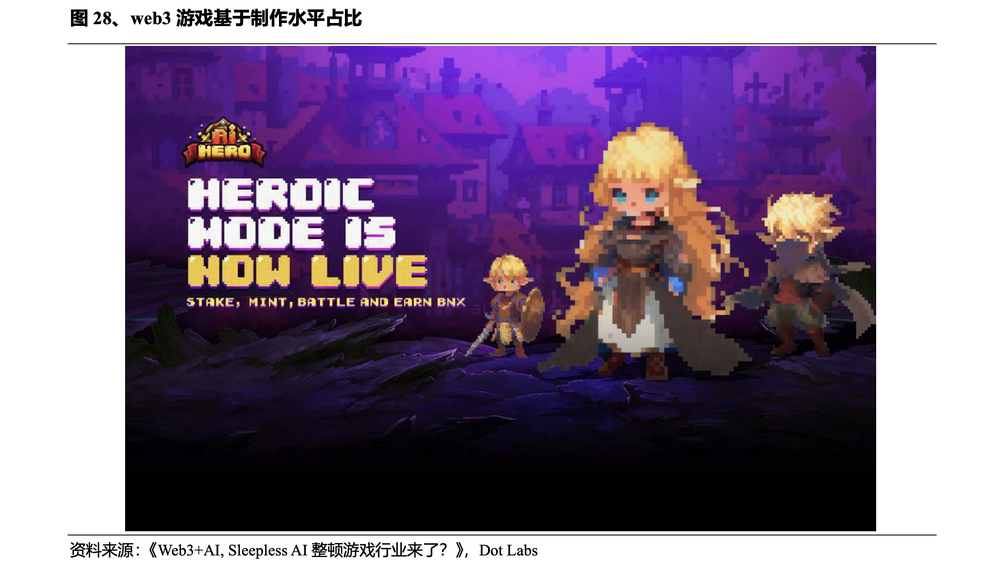
Project Information:
X Account: https://x.com/binary_x
MCP (as of 2024.6.15): 389,304,902
FDV (as of 2024.6.15): 2,220,965,504
(1) Parallel Colony
Another project utilizing AI agents is Parallel Colony. In April 2023, researchers from Stanford University and Google published a paper called "Smallville," detailing how they simulated human behavior by populating a sandbox digital domain with 25 AI agents. Inspired by this paper, Parallel Colony was born. In this game, NFT characters based on AI agents are the main participants, and players only need to guide these NFT characters in the game. The game's AI agents, driven by Avatars, are custom large language models (LLMs) fine-tuned by the Parallel team to better remember experiences and make decisions based on their game memory. This means that the other characters in the game world will not just be non-playable characters (NPCs); they will actually have unique memories and be able to make autonomous decisions in the game world.
Specifically, the semi-autonomous AI avatars of Colony provide a unique architecture, which means that although players have personalized avatars, they must work in coordination with their avatars through general commands to guide them to complete various tasks. Users may suggest to the avatars in the game, "Perhaps you should plant an apple tree for future food?" NPCs will respond to the suggestions, and in some cases, they will interpret them based on other goals they may have— if they feel that the player's suggestion does not align with their characteristics or conflicts with another goal they are pursuing, they may even reject it. In such cases, owners may find themselves debating or coaxing their avatars to complete tasks. Ultimately, the avatars will determine their intended goals—sometimes even disregarding their owner's suggestions—and begin pursuing what they believe to be the most advantageous tasks. Empowered by AI agents, the game world becomes more closely aligned with the real world. This enhances the authenticity and playability of the game.
Project Information:
X Account: https://x.com/ParallelColony
5. AI Unearths User Needs and Increases User Stickiness
The Ultiverse project launched the first AI-driven open metaverse protocol, Bodhi, in early December. As an integrated ecosystem integrator supporting infrastructure and upcoming Dapps, the Bodhi protocol provides momentum for Ultiverse's AI-driven collaborative world vision. For players driven by different gaming motivations, Ultiverse's Bodhi protocol can unearth user preferences and segment player groups using AI, feeding player data back to another AI engine based on multiple real-time algorithms. This allows for real-time adjustments based on player preference data, providing the best experience for players.
AI is the underlying driver, and the game is the landing scene. AI+web3 breaks the limitations of traditional games, providing players with a more personalized experience and achieving refined operations.
Figure 33, Ultiverse Project Roadmap
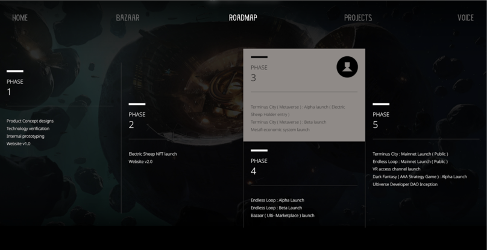
Source: "AI Empowers Games, Can Ultiverse Lead the New Trend of GameFi?", Dot Labs
Project Information:
X Account: https://x.com/UltiverseDAO
MCP (as of 2024.6.15): 38,988,211
FDV (as of 2024.6.15): 278,487,225
6. AI Enhances the Sustainability of Token Economy
Zara Finance
With its unique AI GameFi Pool operation mechanism and focus on the GameFi and NFT niche markets, Zara Finance is becoming a leader in this industry. Zara Finance combines the concept of Defi's vaults and game guild strategies in GameFi, developing a complete AI strategy system. This system not only improves the efficient allocation of resources but also optimizes the returns for players and investors, further promoting the integration of blockchain games and finance.
Zara Finance uses AI technology to select high-quality WEB3 products, creating maximum benefits for users. Its products such as Z-Swap, GameList, and Slaunch not only increase user engagement but also enhance the interactivity and sustainability of the entire ecosystem. Especially in the design of the GUSD algorithmic stablecoin and Zara governance token, Zara Finance demonstrates its advanced thinking in financial engineering, providing users with more stable and trustworthy investment choices.
Project Information:
Twitter: https://x.com/ZaraFinance
7. Providing Infrastructure for AI Empowerment in GameFi
(1)KARRAT
KARRAT is a decentralized gaming infrastructure layer supported by $KARRAT and backed by a truly decentralized community with a common vision, including catering to the new era of gaming, entertainment, and AI products. The KARRAT protocol aims to support the gaming and entertainment industry as well as revolutionary AI innovations in these industries.
Specifically, it includes:
- Funding community projects and rewards
- Developing infrastructure solutions for the gaming and entertainment ecosystem
- Developing storytelling for Web3 native IP
- Establishing alliances with esports organizations
- Partnering with gaming and entertainment studios for their flagship projects
- Building content delivery networks
- Promoting innovation challenges
The highlight of this project is its studio, AMGI Studios, which produces entertainment IP, games, and Web3 native assets using proprietary technology, AI, and real-time animation innovation. AMGI Studios was founded by talents from Pixar, DreamWorks, EA, and Amazon, with a diverse team of over 60 creative and development personnel. AMGI is supported by Epic, Netflix, Coldplay, Polygon, as well as Tony Robbins, Marc Cuban, and Eric Yuan.
Project Information:
X Account: https://x.com/karratcoin
MCP (as of 2024.6.15): 81,821,582
FDV (as of 2024.6.15): 819,161,582
(2)GameGPT
The GameGPT project supports game production technically. GameGPT is an AI-driven game engine that powers the next generation of blockchain games. GameGPT can integrate multiple AI agents to automate parts of the game development process. Each AI agent has its own role, working in an organized manner. Some agents are responsible for reviewing the game's design plans and making corresponding modifications and adjustments; some are responsible for translating tasks into specific code; some are responsible for checking the code generated in the previous step and auditing the running results; and some agents are responsible for verifying whether all the work aligns with the initial expectations.
By breaking down the workflow into detailed tasks, GameGPT can simplify the work of AI agents. This division of labor is more efficient and much simpler to implement than having a single all-encompassing AI agent.
In the game design phase, upon receiving user requests, GameGPT's tasks include generating the entire game development plan. This planning phase is a critical step that greatly influences the seamless progress of the entire development process. This phase is planned by a game development manager based on LLM, who first proposes an initial plan and then breaks it down into a task list.
It is worth noting that due to the inherent limitations of LLM, this initial plan often leads to illusions, resulting in unexpected tasks, including missing information or unnecessary redundant tasks. To address these issues, researchers have proposed four strategies that can mitigate these challenges. These four strategies are mutually orthogonal and can be executed in layers to achieve better results.
Figure 38, GameGPT Project Architecture
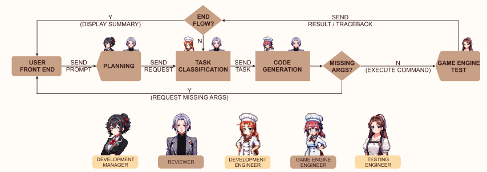
Source: "GameGPT Whitepaper", Dot Labs
Project Information:
X Account: https://x.com/Gamegptofficial
MCP (as of 2024.6.15): 15,751,978
FDV (as of 2024.6.15): 95,654,353
III. Risk Warning
Risk 1: Price Fluctuation
- Cryptocurrency prices fluctuate greatly, and future prices cannot be guaranteed or predicted.
Risk 2: Financial
- The project may go bankrupt due to poor management.
Risk 3: Below Expectations
- The overall development of the GameFi sector may fall below expectations.
Risk 4: Legal
- Some countries and regions prohibit such activities, hindering development.
免责声明:本文章仅代表作者个人观点,不代表本平台的立场和观点。本文章仅供信息分享,不构成对任何人的任何投资建议。用户与作者之间的任何争议,与本平台无关。如网页中刊载的文章或图片涉及侵权,请提供相关的权利证明和身份证明发送邮件到support@aicoin.com,本平台相关工作人员将会进行核查。




